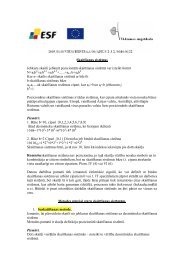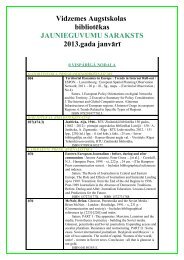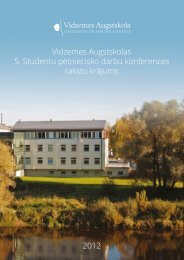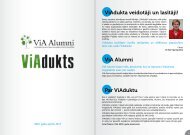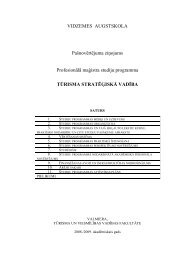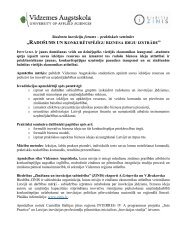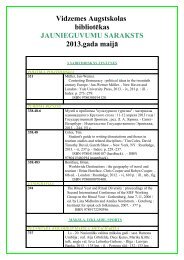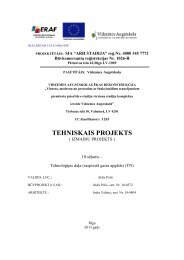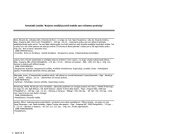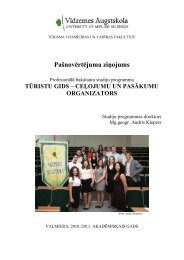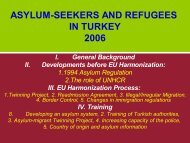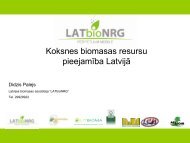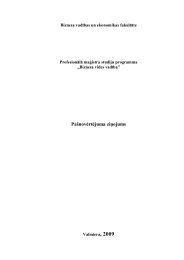Proceedings
Proceedings
Proceedings
You also want an ePaper? Increase the reach of your titles
YUMPU automatically turns print PDFs into web optimized ePapers that Google loves.
Sustainable Planning Instruments and Biodiversity Conservation<br />
is not a depreciation of their capacity to contribute<br />
to habitat conservation, but an acknowledgement<br />
of the distinction between hunting and what is<br />
generally considered to be the rubric of ecotourism<br />
(Isaacs, 2000, p. 62).<br />
As Isaacs clearly states above, consumptive use such<br />
as hunting and fishing is not included in ecotourism.<br />
Tisdell (2003, p. 84) also states that “in general,<br />
ecotourism has been associated with non-consumptive<br />
passive form of wildlife-based tourism,” and Butcher<br />
(2006) describes “ecotourism based development upon<br />
the non-consumption of natural resources.” Kawata<br />
(2008, p. 18) reviewed several definitions of ecotourism<br />
and concluded that it seems that definitions by societies<br />
other than Japan tend to limit ecotourism activities to<br />
non-consumptive ones, whereas definitions by societies<br />
in Japan tend to include consumptive activities.<br />
2.4 Non-Consumptive Use and Its Problems<br />
Until recently, the concern of inappropriate use of the<br />
natural environment has mainly been over consumptive<br />
use issues. One of the examples is the destruction of<br />
wilderness, and ecotourism prevents such activities.<br />
However, there is a possibility that ecotourism causes<br />
excess use by the ecotourists which is beyond the<br />
carrying capacity of the ecotour site. Anyway, the<br />
problem is the degradation of the environmental quality<br />
of the wilderness area caused by over-use. As the<br />
solution, control of usage is essential, and ecotourism is a<br />
promising method. Occasionally, institutional measures<br />
such as access limitation or economic instruments such<br />
as admission charge are used.<br />
Recently, the problem of secondary nature degradation<br />
has worsened. Surprisingly, one of the main reasons<br />
is the under-use of secondary nature. For a deeper<br />
understanding of the issue, it is necessary to introduce<br />
the Intermediate Disturbance Hypothesis of 1978 by<br />
38<br />
protection<br />
conservation<br />
Figure 1.<br />
CLASSIFICATION OF LANDSCAPE<br />
wilderness area<br />
secondary nature<br />
holy place<br />
borrowed landscape<br />
J. H. Connell, which states that biodiversity reaches its<br />
maximum when the disturbance by human beings is<br />
intermediate (Connell, 1978). As this hypothesis suggests,<br />
moderate intervention will create and sustain higher<br />
biodiversity in secondary nature, and the reduction of<br />
intervention will result in the degradation of the quality<br />
of the natural environment.<br />
As we have seen above, reduction of consumptive use<br />
leads to the problem of under-use. In the case of Japan,<br />
forests, storage reservoirs and some wild animals are<br />
typical examples, of which wild animals have caused<br />
severe issues in absence of natural predators (Kawata,<br />
2009a). Moreover, Kawata (2007) points out that underuse<br />
of wild animals may lead to the following two<br />
problems.<br />
Recently, consumptive use has shown a<br />
decrease whereas non-consumptive use has<br />
witnessed an increase. This shift can induce two<br />
problems in the management of game animals in a<br />
scenario encompassing the decline in consumptive<br />
use, increase in non-consumptive use and absence<br />
of predators. [..] The first problem is that as<br />
this shift occurs, the person who utilizes game<br />
animals to gain benefits (user) and the person who<br />
suffers damage (victim) may not be the same. [..]<br />
The second problem is that the utilization of game<br />
animals as beneficial animals will not alleviate<br />
the damage they cause as pests (Kawata, 2007,<br />
pp. 349–350).<br />
An outline of the aforesaid is presented in Figure 1.<br />
Because of over-consumptive use, precious species of<br />
animals and plants have been destroyed in the wilderness<br />
area and regional resources have been depleted in<br />
secondary nature. Ecotourism and green tourism have<br />
been planned to prevent the occurrence of these issues.<br />
On the other hand, consumptive under-use of secondary<br />
rural landscape<br />
urban landscape<br />
cultural landscape<br />
eco tourism<br />
green tourism<br />
over-use:<br />
excess<br />
consumptive<br />
use<br />
COUNTERMEASURES<br />
consumptive<br />
tourism<br />
under-use:<br />
under<br />
consumptive<br />
use<br />
CAUSES OF THE PROBLEMS<br />
nature has brought uncontrolled regional resources,<br />
which result in the reduction of biodiversity and other<br />
issues. However, in case of a wilderness area, under-use<br />
issues will not be revealed because it is desirable for this<br />
area to remove any effect of human beings.<br />
3 Consumptive Tourism<br />
3.1 The Reason for Decline in Consumptive Use<br />
The reason why we need to promote consumptive tourism<br />
is just as we discussed above: reduction of the negative<br />
influence of consumptive use on secondary nature. This<br />
negative influence may result in a negative impact on<br />
human society. For example, if we abandon agricultural<br />
activities, the multi-functionality of agricultural lands<br />
may be lost and biodiversity may decrease, all of which<br />
is a loss for human society.<br />
Then, although we know it will have negative impacts<br />
on human society, what is the reason for the decline of<br />
consumptive use? Here we discuss two topics. Firstly, it<br />
is concerned with the fact that secondary nature is a kind<br />
of public good, as it is well-recognized in social sciences.<br />
Public goods have two characteristics: non-rivalness and<br />
non-excludability. Non-rivalness means that consumption<br />
by one person will not reduce the consumption of another<br />
person. Non-excludability means that it is impossible to<br />
exclude those who refuse to pay for use.<br />
A number of people may understand that, as the use<br />
of secondary nature decreases, the quality of secondary<br />
nature will also decrease. However, even if everyone<br />
concerned understands this concept well, the use of<br />
secondary nature will decrease. This is because once a<br />
person engages in agricultural activities at a cost, others<br />
enjoy benefits generated from this secondary nature<br />
without bearing any cost. In short, the so-called free<br />
ride problems occur. Once consumptive use has started<br />
to diminish, because of the free ride problem, most of<br />
the people may refuse to take actions for stopping this<br />
diminishment.<br />
Nonetheless, the description above does not explain<br />
why consumptive use starts to diminish. To explain<br />
this, we pose the following hypothesis: in short, the use<br />
of secondary nature is also under the influence of the<br />
Petty-Clark’s law. This empirical rule states that as the<br />
national income level improves, the weight shifts from<br />
the primary industry to secondary and tertiary industry.<br />
It was stated in “The Conditions of Economic Progress”<br />
by C. Clark in 1940 and confirmed by S. S. Kuznets<br />
in “Modern Economic Growth” in 1996. The original<br />
idea appeared in “Political Arithmetick” by W. Petty<br />
in 1690.<br />
Use of agricultural lands and artificial forests is<br />
included in the use of secondary nature, all of which<br />
is classified as activities in the primary industry.<br />
Based on the Petty-Clark’s law, the primary industry<br />
Consumptive Tourism and Conservation of Natural Resources<br />
weakens as the national income increases; it follows<br />
that agricultural lands and artificial forests will not<br />
be maintained in time. Human beings have influence<br />
on the natural environment through hunting activities,<br />
which may maintain population size of game ungulates<br />
at low level. Once hunting has been abandoned, such<br />
influences diminish, resulting in the increase of<br />
ungulates; consequently, the rural landscape, where<br />
ungulates reside, will change. As we have already<br />
seen, if predators do not exist, it may result in a drastic<br />
deterioration of the rural landscape.<br />
Above we suggested that the Petty-Clark’s law may<br />
explain the reason for the consumptive use diminishment<br />
and pointed out the free ride problem because of the failure<br />
to stop consumptive use diminishment. Consumptive<br />
tourism is necessary because, as we will examine in<br />
the next section, it seems to be an effective method to<br />
prevent the diminishment of consumptive use.<br />
3.2 Validity of Consumptive Tourism<br />
In what follows, we will discuss the effectiveness of<br />
consumptive tourism for sustaining consumptive use.<br />
We suggested the Petty-Clark’s law to explain the reason<br />
for consumptive use diminishment, but this law is an<br />
empirical rule and not the norm. It means that human<br />
society need not advance in the direction this law<br />
suggests; otherwise some issues concerning consumptive<br />
use diminishment will occur. In short, at least in the<br />
context of consumptive use, we need not emphasize the<br />
Petty-Clark’s law.<br />
However, then we have some doubt: whether<br />
it is possible to put the brakes on consumptive<br />
use diminishment through the implementation of<br />
consumptive tourism. For this doubt, we have the<br />
following suggestion: even if industries shift from<br />
primary to secondary and tertiary, we need to consume<br />
a certain amount of products from the primary industry.<br />
Therefore, the point is if there is profit from producing<br />
agricultural products and/or hunting game animals to<br />
provide meat, and other satisfactory outcomes, as long<br />
as these activities are as profitable as other industries,<br />
it must be possible to maintain consumptive use.<br />
Consumptive tourism can be regarded as a system which<br />
produces these benefits.<br />
In addition, sometimes an exceptional case may<br />
occur. For example, Kawata (2009b) points out based<br />
on the data of 19 European countries that game hunting,<br />
which is one of consumptive uses, has increased when<br />
the per capita GDP is between 10 000 and 20 000 USD,<br />
but once the per capita GDP crosses 20 000 USD, two<br />
groups come to the fore. In one group, the number of<br />
hunters continues to increase, whereas in the other<br />
group, the number of hunters decreases. It suggests that<br />
for several reasons, there will be exceptional situations<br />
of the Petty-Clark’s law.<br />
39



